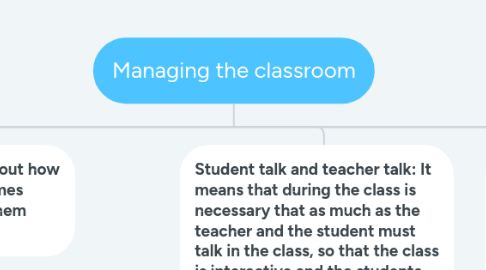
1. Classroom management: It consists of being able to handle a range of variables eg. how the classroom space is organised how we organise classroom time, how we appear to the students and how we use our voice.
2. The teacher in the classroom: It´s about the way we move and stand, and the way we are able to respond to what happens in class.
2.1. Using the voice: It means how we speak and what our voice sounds like have a crucial impact on classes.
2.1.1. -Audibility: The teacher must be sure that students at the back of the class can hear him just as well as those at the front, but without divorced from voice quality.
2.1.1.1. -Variety: It means teacher need to vary the quality of his voice, the volume he speak at, according to the type of lesson and the type of activity.
2.1.1.1.1. -Conservation: Teachers have to take great care of their voice, it means they have to handle correctly the way they breathe so that they don not strain their larynxes.
2.2. -Proximity: When teachers think about how close they should be to the students they are working with.
2.2.1. -Appropriacy: When teacher decides the appropriacy way to close to the students when they work with them.
2.2.1.1. -Awareness: When teachers have to be aware of what students are doing and, where possible, how they are feeling. Awareness means assessing what students have said and responding appropriately.
3. Talking to students: The way that teachers talk to students is not the same as that among parents and friends, when teachers talk with their students their vocabulary is generally more restricted, they make more frequent attempts to establish eye contact and they use other forms of physical contact.
3.1. Three things teachers need to be aware:
3.1.1. 1-They should consider the kind of language that students are likely to understand.
3.1.1.1. 2-They need to think about what they wish to say to the students and how best to do it.
3.1.1.1.1. 3-They need to consider the manner in which they will speak.
4. Giving instructions: It about how to talk to students becomes crucial when they give them instructions.
4.1. Two general rules for giving instructions:
4.1.1. 1- Teacher must be kept as simple as possible.
4.1.1.1. 2- Teacher must be logical.
4.1.1.1.1. Before to give instructions teacher needs to organised the information step by step.
5. Student talk and teacher talk: It means that during the class is necessary that as much as the teacher and the student must talk in the class, so that the class is interactive and the students feel interested.
6. Using the L1: When the students are beginners is appropriate for them to use the L1 in class when their main object is, after all to learn an L2, students are going to translate what is happening into their L1, that is normal at their level, but it does not mean that they will be talking all the time in L1. For that reason is necessary teachers use L2 as often as possible, and not to spend a long time talking L1 with their students.
7. Creating lesson stages: When teacher arrives in the classroom, is necessary to start the lesson off in such a way that the students´ interest is aroused so that they become engaged.
8. Different seating arrangements:
8.1. -Orderly rows: The teacher has a clear view of all the students can all see the teacher. Orderly rows imply teachers working with the whole class.
8.1.1. -Circles and horseshoes: Classes which are arranged in a circle make quite a strong statement about what the teacher and the students believe in.
8.1.1.1. -Separate tables: When students sit in small groups at individual tables, it is much easier for the teacher to work at one table while the others get on with their own work.
9. Different student groupings:
9.1. -Whole class: Type of classroom organisation in which teacher working with the class as a whole group by treating everyone as part of the same group.
9.1.1. -Groupwork and pairwork: They both foster coperative activity in that the students involved work together to complete a task.
9.1.1.1. -Solowork: It allows students to work at their own speed, allows them thinking time, and allows them to be individuals.
9.1.1.1.1. - Class-to-class: When teacher joing two different classes so that students can interact with each other, in that way students can feel motivated to learn more.
